A Guide to Understand Food Web with Diagram
All the animals present in an ecosystem have a closely-knit relationship. Their food habits and praying nature maintain an ecological balance. Therefore, their adaptability, competitiveness, population, etcetera can affect the ecosystem. To learn about the complexity of the food web and the energy flux, the students can use a food web diagram. They must choose the EdrawMax Online tool to create a high-quality food web diagram.
1. What is Food Web
A food web is an ecological concept based on food and energy transfer. It shows the relationship of animals present in a particular habitat or ecosystem. A food web is a combination of several food chains. This food flow also depicts the flow of energy from the producers to the consumers. The terrestrial food web is different from an aquatic food web. The structure of the food web is dependent on the species of animals present in the particular ecosystem. The basic idea of the food web is the transfer of food and energy from autotrophs to carnivorous or omnivorous animals. There are mainly two ways of food webs. They are:
- The grazing food web
- The detrital food webs
In the grazing food web, the nutrients get circulated from plants to carnivorous or omnivorous animals. The green plants are the primary producers or autotrophs. The nutrients from them are passed on to the primary consumers or herbivores. Rabbits, grasshoppers, ground squirrels belong to this category.
These herbivorous animals are preyed upon by carnivorous animals and can be two types of animals, primary and secondary. The primary animals get their nutrients from the herbivores and then pass the same to the secondary carnivores. All the animals in a grazing ecology form a complex food web that shows the transfer of nutrients and energy from green plants to the highest level of the food web.
At the same time, the detrital food web starts with the decomposers or the organism feeding on the decaying substances. They are also called the detritivores. The detrital food web shows a massive amount of energy flow in the ecosystem. The primary consumers present in the detrital ecosystem are fungi, bacteria, protozoa, and other microbes.
 Source:EdrawMax Online
Source:EdrawMax Online
1.1 The Functions of Food Web
As the food web describes the relationship between different species of animals through its complex net-like structure, there are three types of food web diagrams:
- Connectedness Web: This type of web shows how the feeding relationship of the species depends on each other.
- Energy Flow Web: The energy flow web depicts the transfer of energy flux from the producers to the other species of animals.
- Functional Web: The functional web shows how the relationship between two species present in the ecosystem who are dependent on each other can also affect the population and growth of the animals.
The central function of the food web is to establish a relation between the animals present in the ecosystem, there are other applications of the food web, and those are:
- Finding out the interdependency of the species present in an ecosystem.
- Having ideas about the growth and population of species of animals present in an ecosystem.
- A food web shows how the complex chains help in maintaining an ecological balance.
- It can explain the adaptability and competitiveness of different species present in the same ecosystem.
1.2 The Food Web vs. Food Chain
The food chain and food web both show how the food and the energy flux gets transferred from one species to another. However, there are specific differences between the food chain and the food web.
- A food chain shows a linear and one-way energy transfer, while in the case of a food web, the energy transfer is more complicated, and there are interconnected pathways.
- The food chain is one-way and hence creates instability in the ecosystem. The food web, on the other hand, has a net-like representation of the energy flow. It expresses the stability in the ecosystem.
- The food chain is a graphical representation of the interrelation between two species separately. On the other hand, the food web is more realistic and represents the relation between the animals present in the ecosystem.
- The food chain may have five or six trophic levels, beginning with the autotrophs at the first level. The food web can have unlimited trophic levels, given the nature of the ecosystem and the animals present in it.
- Students can use the food web to find out the adaptability and competitiveness between the species of animals present in the ecosystem. It has a complex structure that explains the relationship between the animals, while the food chain fails to explain.
- The food chain shows that the animal of a trophic level is fed on the animals that belong to the trophic level immediately below. The food web gives an idea about the complex food relationship. The fact is that an animal of a high trophic level can consume animals of multiple trophic levels below them.
2. How to Draw the Food Web Diagram?
The students can learn the food web and the animals present in it with the help of a food web diagram. But create this diagram is difficult, here are two ways to guide you how to draw the food web diagram.
Scan Now
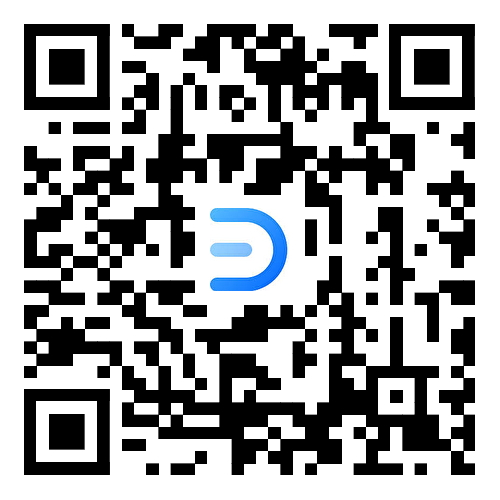
2.1 How to Create Food Web Diagram from Sketch
Creating such a diagram by hand can be difficult. The students can follow these steps to make their food web diagram:
Step 1: The students need to consider the habitat they are considering for their food web and list the animals present in the habitat before they start with the food web diagram.

Step 2: The students can write the name of the animals on a large piece of paper and then link them based on the animals, whom they consume, and who consume them. It is the most complicated part of the food web, and they need to keep in mind that there are animals who feed on multiple animals.
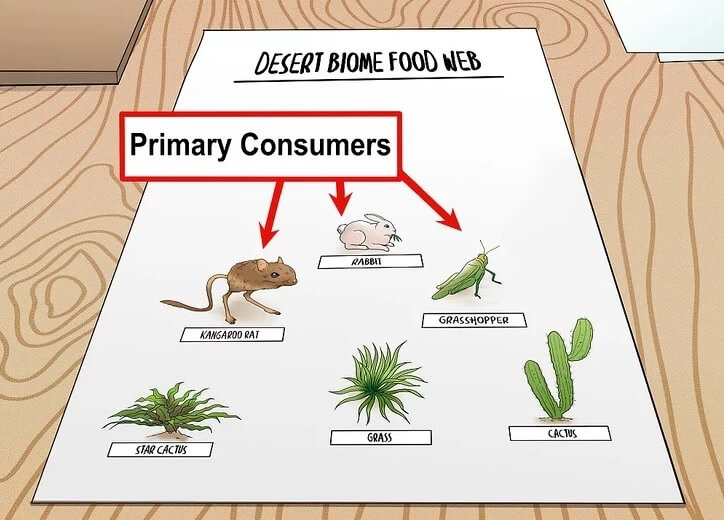
Step 3: Once the linkage is complete, the student can name the chart on their ecosystem.
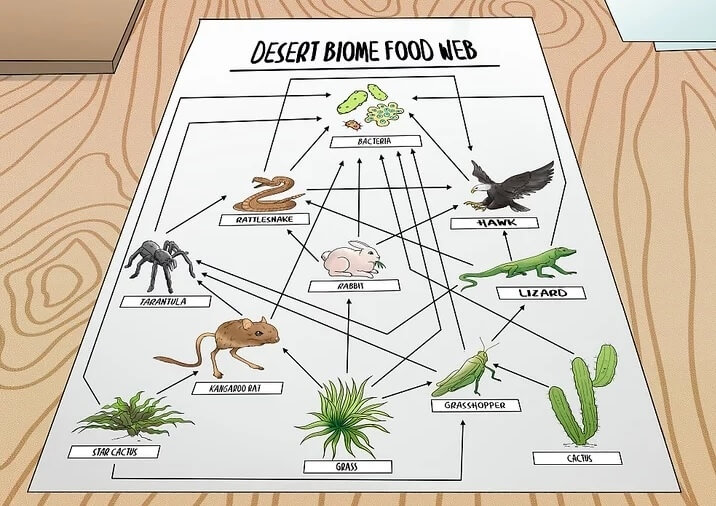
2.2 How to Create Food Web Diagram Online
Since the food web depicts the complicated relationship between the species present in the same ecosystem, the students may find it hard to create a food web diagram by hand. For that, they must use the EdrawMax Online tool. They can draw a food web diagram with these few simple steps:
Step 1: EdrawMax Online is an easy-to-use tool, and the students can comfortably work on them. First, the students need to open the EdrawMax Online tool and then Open New. They can find the Science and Education option here.

Step 2: The students can use this tool to create multiple science and education-related diagrams. They can click on the Biology option to find the Food Web diagrams. They can select the food web diagram they require and then modify it as per their requirements.

Step 3: After selecting the template they require, the students should modify it as per their choice. The tool gives the students some hassle-free options to edit their diagrams. They can work on those images according to their preference to create a high-quality food web image.

Step 4: Once they finish, they can save the file in multiple formats and then export for using them for their lessons or projects.

3. The Food Web Examples
The food web can be of different types; as the habitat changes and the nature and number of species change, there can be more complexities in the representation of the food web. Here are a few examples of the food web to show the interrelationship of different species of animals present in the same ecosystem:
- Soil Food Web
This is an example of a detrital food web diagram as it starts with the decomposers or the worms. They add nutrients to the soil, which the autotrophs use. The primary consumers like grasshoppers and squirrels eat the plants, while secondary consumers like frogs and snakes feed on them. The foxes and hawks are the tertiary consumers who prey on the frog and snakes. After the death of the tertiary consumers, their bodies the worms decompose their bodies.
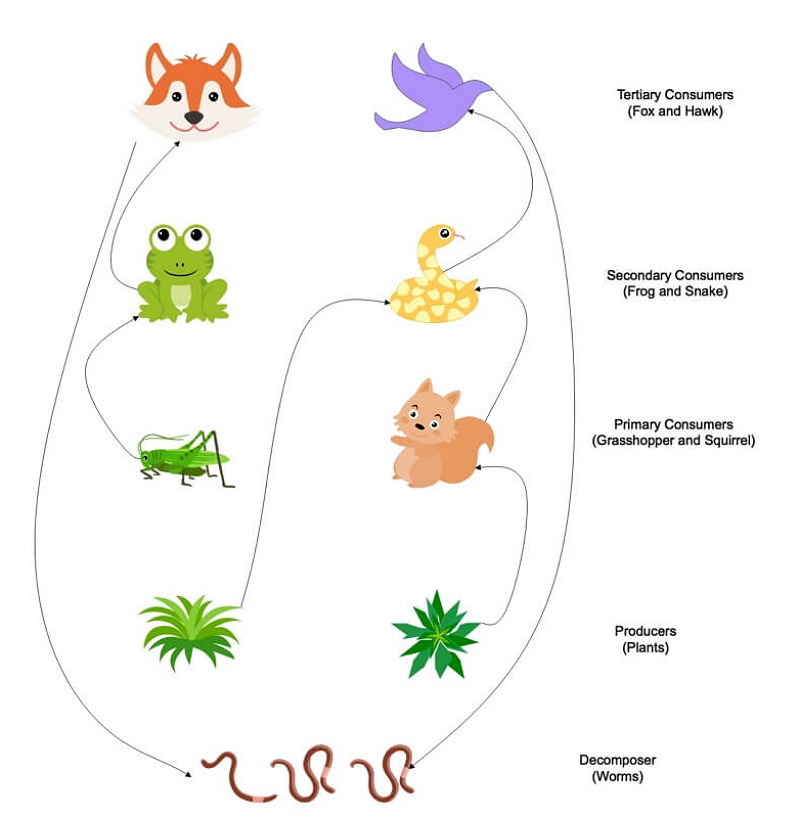
- Desert Food Web
The desert is a habitat with little water. The desert is not all hot. Some deserts are very cold. In the desert food web, the producers are usually cacti, shrubs, acacias, flowers, and brushes, the main consumers are insects, lizards, rodents, and the secondary consumers are tarantulas, scorpions, lizards, snakes, and tertiary consumption Those are eagles and foxes.
In the food web, cacti are eaten by insects, lizards or rodents. These insects can be eaten by tarantulas, scorpions and lizards. Then the lizards were hunted by snakes, foxes and eagles. There is diversity among their diets.
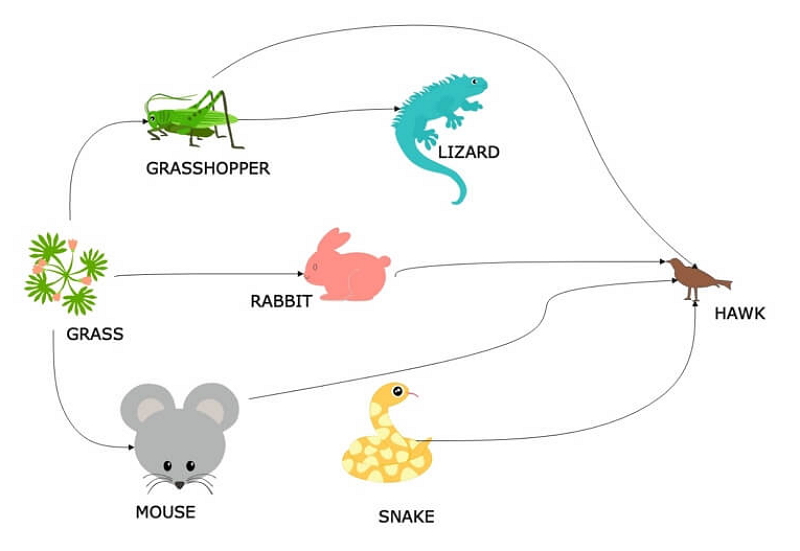
- Ocean Food Web
There is diversity in marine life. In the marine food web, the producers and decomposers are usually seaweed, seaweed, algae, plankton, and bacteria. The main consumers are sea turtles, damselfishes, crabs, and shrimps, and the secondary consumers are octopus, triggerfish, squid, and phosphorus. Shrimp, and third consumers are seagulls, penguins, elephant seals, and whales.
If you observe the food web at the bottom of the sea, you will see krill eating plankton. Then the krill will be eaten by fish or whales. That fish may be eaten by seagulls or seals.
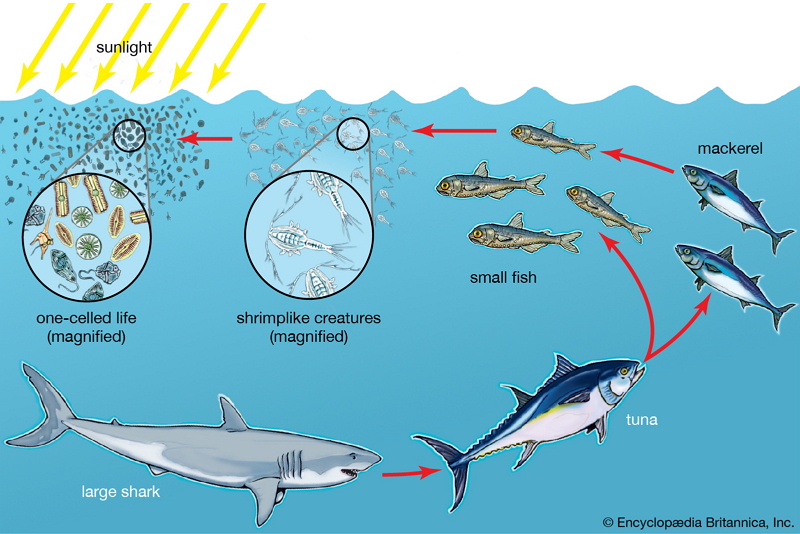
- Coral Reef Food Web
Abiotic factors can affect the health and development of coral reefs. Coral reefs are one of the most biologically diverse ecosystems in the world. Sponges, jelly, shrimp and sharks are just some of the creatures called coral reef homes. Coral reefs provide a place for organisms to lay eggs, care for, refuge or forage.
The main producers of the coral reef food web include plants and seaweed. The energy produced by producers in the coral reef food web goes to primary consumers. Intermediate predators prey on primary consumers in the coral reef food web. Top predators prey on intermediate predators in the food web of coral reefs. The decomposer is an indispensable part.
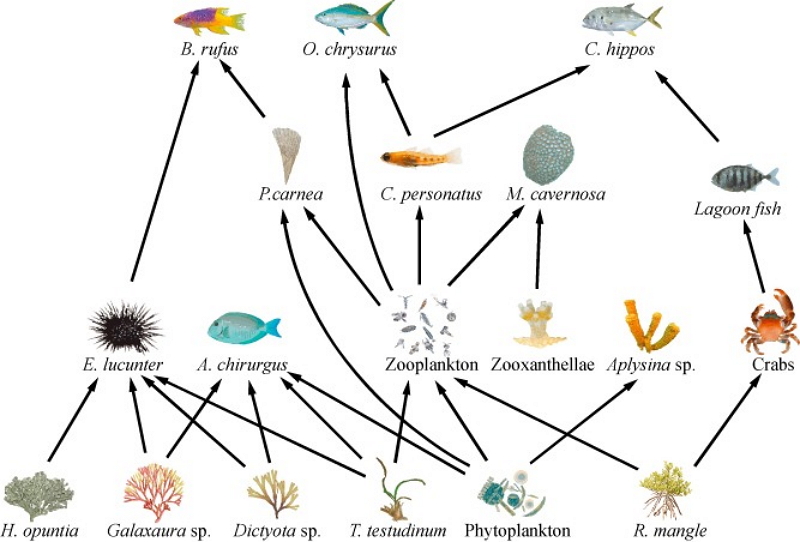
4. Conclusion
Food web diagram is a complicated structure as there are multiple animals present in the system. The energy flow in the food Web depends on the habitat and the animals present in the habitat. Therefore, learning about a food Web is difficult. They can use a food web diagram for that. However, creating a food web diagram by hand can be difficult. They can use the EdrawMax Online tool, which can help them in drawing a high-quality food web diagram.
In conclusion, EdrawMax Online is a quick-start diagramming tool, which is easier to make food web diagram and any 280 types of diagrams. Also, it contains substantial built-in templates that you can use for free, or share your science diagrams with others in our template community.






